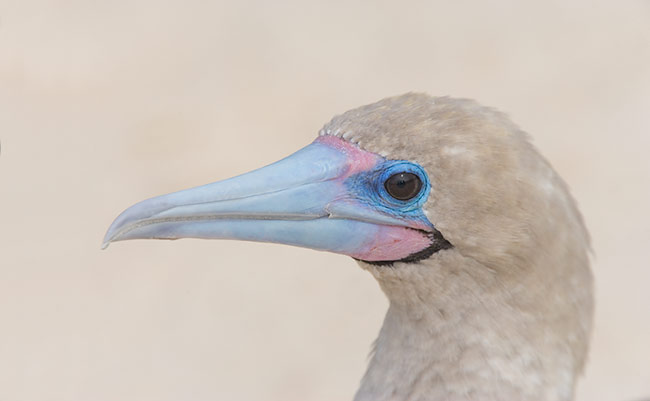
BIRDS AS ART BULLETIN 205
JULY28,2006
Visit www.birdsasart.com
AN EXTENSIVE FIELD TEST REPORT: THE CANON 400mm DO LENS VISITS ECUADOR
GALAPAGOS TRIP REPORT
MORE POSSE MAZEL TOVS
PRODUCT UPDATES
POSSIBLE ANTARCTICA OPENING
ALBUQUERQUE SEMINAR
DELKIN e-FILM PRO COMPACT FLASH CARDS/CRAZY LOW PRICES
IPT UPDATES
Contact us by phone at 863-692-0906 (Eastern Time Zone) or by e-m ail at birdsasart@att.net or birdsasart@verizon.net. The att address is best from overseas.
We gladly accept credit card orders by phone 8am till 9pm Eastern Time.
You can use the Paypal links on the web site to order anything. Just type in the item(s) and the amount due. If using your own Paypal account, please send to either of the e-mail addresses above.
Photographic Theme: Some of my favorite images from my recent Ecuador trip created with the Canon 400mm f/4 IS DO lens.

Red-footed Booby, Darwin Bay, Tower Island, Galapagos, Ecuador
Image copyright 2006: Arthur Morris/BIRDS AS ART
Canon 400mm f/4 IS DO lens (tripod-mounted) with 1.4X II TC and EOS-1Ds Mark II. ISO 400. Evaluative metering +2/3 stop: 1/640 sec. at f/10.
With a clean sand background, I simply lowered my tripod and used some extra depth of field to ensure that the entire bill would be sharp (even though I focused on the eye).
AN EXTENSIVE FIELD TEST REPORT: THE CANON 400mm DO LENS VISITS ECUADOR
The day before I was scheduled to leave for three weeks in Ecuador, a quick visit to the doctor revealed that I had an inguinal hernia. As my shoulder had been bothering me for a while (again), I had considered leaving my beloved 500mm f/4L IS lens home and taking the 400mm DO lens that I had borrowed from Canon Professional Services. After discovery of the hernia, m y decision was an easy one. Note: without getting too technical, Canon DO lenses feature a Multi-Layer Diffractive Optical Element that results in lenses that are physically smaller and considerably lighter than similar lenses made only with traditional refractive optical elements. The Multi-Layer Diffractive Optical Element (which is the front lens element group) eliminates chromatic aberration caused by the refractive lens group. Chromatic aberration is suppressed to an absolute minimum . Furthermore, the aspherical effect corrects for spherical and other aberrations. The resulting high resolution and high contrast ensures outstanding image quality.
The most attractive attribute of the 400 DO is its extremely light weight: 4/1 2 pounds complete, and a shade under 4 pounds with the lens hood and the tripod collar removed. I had used this lens briefly right after it was released in 2001 and was impressed by the sharp images it produced even when used with the 2X teleconverter. I will confess, however, that I was a bit nervous about having to rely on the 400 DO as my big lens on a major outing, three weeks in Ecuador that included two Galapagos cruises that I led for my pal Janie Bullard of Distinctive Journeys. In a word, I was most impressed with the lens and with the quality of the images. In addition, with Image Stabilization, the 400 DO is surely the best lens around for use when photographing from a panga (Ecuadorian for Zodiac or skiff), a canoe, a kayak, a boat or ship, or any type of watercraft. I chose a Gitzo 1325 carbon fiber tripod topped with a Mongoose M-262 because the V-2 Wimberley head is overkill for lenses in the class of the 400mm DO.
The first time that I attempted to autofocus with the 400 DO/2X TC, EOS-1Ds Mark II combination I was dismayed at the slow response but afterwards realized that the slow initial AF acquisition was due more to the low-light conditions and my failure to pre-focus manually than to a problem with the lens itself. On the two Galapagos trips I carried the tripod-mounted 400 DO on all of our landings and handheld the lens extensively when we photographed from the pangas (with and without the 1.4X TC). On the islands I used the prime lens alone at times, and often with either the 1.4X or 2X teleconverter. On occasion I removed the lens from the tripod and handheld it, usually--but not always--for flight photography.
Between m y two trips to the archipelago, I visited several cloud-forest locations to the northwest of Quito for 2 days and created images of perched hummingbirds using the 400 DO most of the time with the 2X TC and 25mm or m ore of extension. I used flash as main light techniques as I was working in extremely low light conditions. Because I was using the 2X and because it was so dark (I was usually 2-3 stops underexposed even when using ISO 800) I quickly realized that focusing manually was the only option. While I was pleased with the sharpness and the quality of the images made in the Galapagos (all without flash), I was totally amazed by the sharpness and the astounding quality of the hummingbird images.
My biggest problem with the 400 DO lens is the inadequate minimum focusing distance (MFD) of 3.5 meters (nearly 11 feet). Compare this with the Nikon 200-400 VR lens that focuses under 7 feet. With many of the birds and animals in the Galapagos being utterly tame and ridiculously approachable and with the tiny size of the hummingbirds, the 400 DO's 11 foot MFD was often a problem . This was especially true with the hummingbirds as light loss with the 2X and the tubes was substantial. Had I been able to focus closer I would have often been able to get away with only the 1.4X TC (and some extension).
After working with the 400 DO lens every day for nearly three weeks my shoulder is in A-one shape, my hernia undamaged, and I am the proud owner of 136 new family jewels created with this excellent lightweight lens. If you are looking to get into super-telephoto photography but have a problem carrying lenses in the seven to 13 pound class, the 400 DO just might be perfect for you. And the same might be true if you are looking for a fast, hand-holdable telephoto lens. (I have several friends and clients who own and use this lens (contrary to my advice!) exclusively without a tripod.
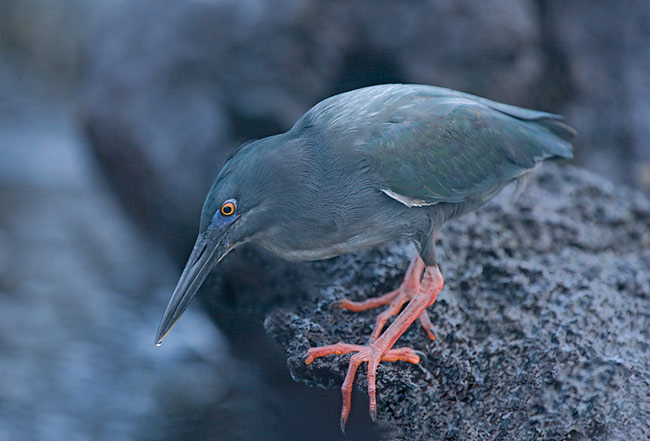
Lava Heron, Sullivan Bay, Galapagos, Ecuador
Image copyright 2006: Arthur Morris/BIRDS AS ART
Canon 400mm f/4 IS DO lens (handheld) with EOS-1Ds Mark II. ISO 800. Evaluative metering -1/3 stop: 1/250 sec. at f/4.
This image was created while photographing from a rocking Zodiac in very low light while handholding (the only option with six or seven photographers in the boat). Of a long series, this was by far the sharpest image of this bird, the only individual of this species that we saw in full breeding plumage. As I clipped the toes, I added canvas, a bit to the longest toe, and 1 toenails.
.....
400 DO TIPS
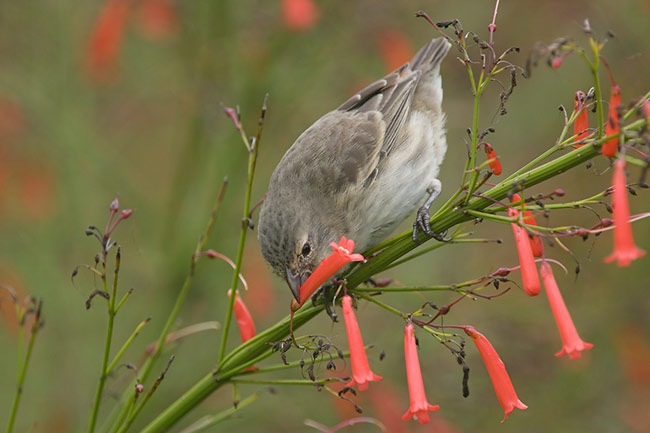
Woodpecker Finch, female, Puerto Ayora, Galapagos, Ecuador
Image copyright 2006: Arthur Morris/BIRDS AS ART
Canon 400mm f/4 IS DO lens (tripod-mounted) with 2X II TC and EOS-1Ds Mark II. ISO 800. Evaluative metering at zero: 1/200 sec. at f/10.
Whenever I am working with a 2X TC and an f/4 lens I stop down a bit (from f/8) for some additional sharpness. With that combination and a Canon professional body AF functions, but only the central sensor is active. With the bird leaning down to pierce a flower, I was able to include all of the lower blossoms while placing the AF sensor on her eye.
GALAPAGOS TRIP REPORT
The good news: despite some new itinerary restrictions the Galapagos continues to be one of the world's great wildlife photography destinations. All 23 folks in each of this year's two groups were afforded countless opportunities to photograph a variety of ridiculously tame birds, sea-lions, iguanas, and crabs. I have found the world's best Galapagos photography guide, Juan Salcedo. Juan worked hard to protect the wildlife and the habitat of this remarkable archipelago while at the same time allowing us a bit of freedom so that we could enjoy additional superb opportunities without harming either the wildlife or the vegetation. His knowledge of the animals, plants, geology, and history of the area seemed boundless and he was always will to share everything he knew about the region. His love for the area was evidenced by the passion he exhibited while leading each group. I am working hard to secure Juan's services for all future Galapagos cruises. Right now the single cruise next summer is sold out with a waiting list. I am planning to return again in the summer of 2008 for a single cruise. If you are a happy person (see below) and a relatively competent photographer who is interested in joining me in the Galapagos in July 2008, please let me know via e-mail. As always, this cruise will sell out within days when it is formally announced.
More than one photographer arrived in Ecuador without having the basic knowledge needed to operate their camera. Even on Instructional Photo-Tours folks are expected to be familiar with the basic operation of their cameras and lenses, and that goes double on Photo Cruises and Photo Safaris. Our IPT cover-letters stress the fact that folks are expected to know how to operate their cameras, to know how to set exposure compensation, and to be able to know when, how, and why to choose and set either AI Servo or One-Shot AF. While having posse members attend regularly scheduled IPTs whenever possible to give additional help to beginners, having them along on Photo Cruises and Safaris is simply not feasible.
Unfortunately, with the first group, the usual BIRDS AS ART love-fest atmosphere did not develop. Several folks--on occasion--were rude to the guide and to other members of the group. In addition, and much to my amazement, there were folks on each cruise who violated park regulations even though Juan had been crystal clear as to what we could and could not do on each island during the daily orientations. As regular Bulletin readers know, BIRDS AS ART IPTs, Photo Cruises, and Photo Safaris generally attract happy pleasant folks who, despite being competent photographers (do note that this group includes beginners, intermediate and advanced photographers, and even professionals) are eager to learn...
You can see a complete collection of my most recent Galapagos family jewels images here: www.birdsasart.com/ecuadorhtml
After clicking on the first thumbnail to enlarge the image you can click "Next" to continue in slide show mode (or scroll down to see the IPTC data).
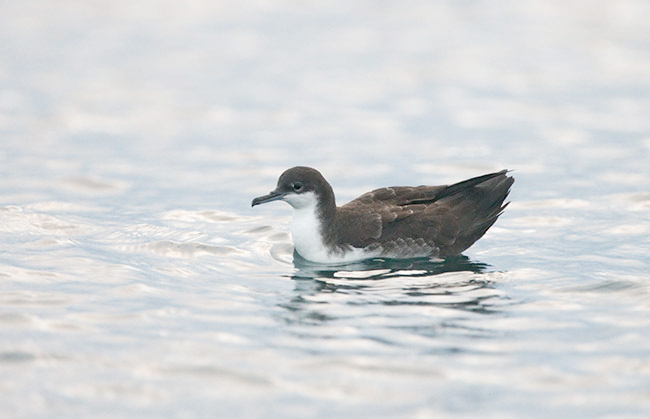
Galapagos Shearwater, Prince Phillips Steps, Tower Island, Galapagos, Ecuador
Image copyright 2006: Arthur Morris/BIRDS AS ART
Canon 400mm f/4 IS DO lens (handheld) with EOS-1Ds Mark II. ISO 1600. Evaluative metering +1 2/3 stops: 1/500 sec. at f/4.
Simply put, the 400 DO is deadly from a boat This image was created in near impossible conditions: at dusk from a rocking boat filled with eight frantic photographers┘ Note the exposure compensation: when the sun is not at full strength, your evaluative and matrix meters are dumb!
MORE POSSE MAZEL TOVS
Congratulations to Todd Gustafson whose ground-level image of courting flamingos (taken at Lake Nakuru last summer on our Photo Safari) was awarded runner-up in Bird Behavior in the 2006 Shell BBC Wildlife Photographer of the Year Competition. He will be traveling to London for the award ceremony this coming October. (We already let you know about Robert O'Tooles exploits in the same contest in a previous Bulletin.
Congratulations also to Posse member Robert Amoruso whose Royal Tern courtship image was awarded first place in the Birds category of the 2006 Nature's Best Photography International Photo Awards Competition.
I am very proud of Todd, Robert, and Robert and am lucky to have such skilled photographers (and instructors) assisting me on the IPTs.
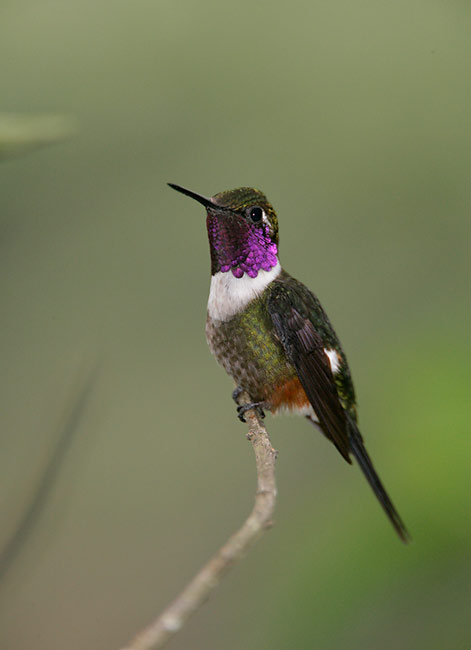
Purple-throated Woodstar, male Tandayapa Bird Lodge, Ecuador
Image copyright 2006: Arthur Morris/BIRDS AS ART
Canon 400mm f/4 IS DO lens (tripod-mounted) with 37mm of extension, 1.4X II TC, and EOS-1Ds Mark II. ISO 800. Evaluative metering -2/3 stop: 1/100 sec. at f/5.6. Flash as main light at zero with Better Beamer. (AI Servo AF with an upper sensor≈3 up from the center--selected manually.)
When using the 1.4X TC with the 400 DO lens, AF was fairly responsive even in low light. I had only a single chance with this species on a clean perch (that lasted all of five seconds) at Tandayapa. My heart was pounding but I made the most of it.
PRODUCT UPDATES
For the first time in recent memory we now have Version II Wimberley heads, BLUBBs, and Mongoose M-262 tripod heads in stock. Demand for these three items has been so high that we have not been able to keep them on the shelves. I recently tried my old Wimberley head just for the heck of it and it really helped me realize how much better the new head is... The position of the horizontal pan knob makes handling the head so, so much easier, and that will go triple once it gets cold; the new knob is knurled for easy gripping even with gloves on. We have now sold more than 240 BLUBBS and have received only rave reviews. For info on all of our products see the links on the home page: www.birdsasart.com
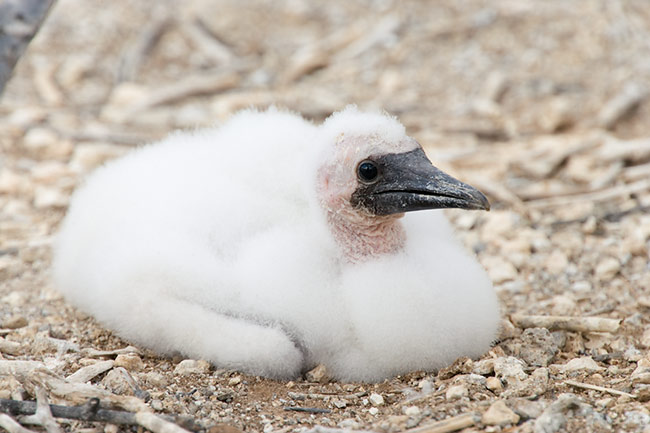
Nazca Booby chick, Prince Phillips Steps, Tower Island, Galapagos, Ecuador
Image copyright 2006: Arthur Morris/BIRDS AS ART
Canon 400mm f/4 IS DO lens (tripod-mounted) with 2X II TC and EOS-1Ds Mark II. ISO 400. Evaluative metering +2/3 stop: 1/200 sec. at f/11.
I was so enthralled with the Nazca Booby nesting activity at the top of the steps that I stayed with them for more than an hour. The 400 DO/2X TC combination proved to be exceptionally sharp.
POSSIBLE ANTARCTICA OPENING
Due to a cancellation, there is an opening on this January's Antarctica trip. If you are seriously interested, please contact Janie Bullard immediately via e-mail (janie@distinctive-journeys.com) and she will see if it is possible to confirm you on the trip (rather than have Zeagram's fill the spot from their long waiting list).
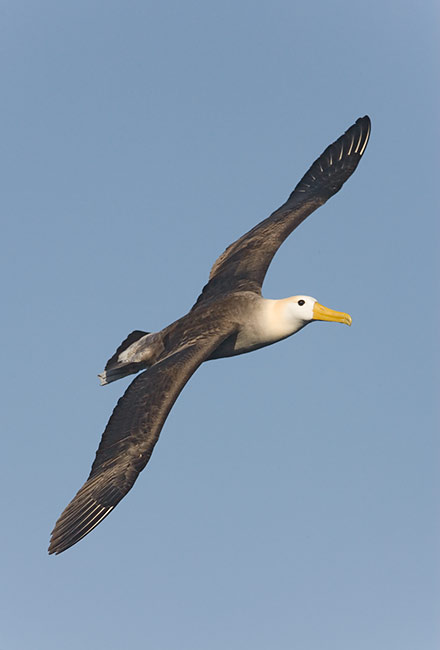
Waved Albatross, Hood Island, Galapagos, Ecuador
Image copyright 2006: Arthur Morris/BIRDS AS ART
Canon 400mm f/4 IS DO lens (handheld) with EOS-1Ds Mark II. ISO 250. Evaluative metering -1/3 stop: 1/1000 sec. at f/10.
The 400 DO is a great lens for handheld flight photography. In situations like this, rely on highlight alert rather than the histogram to see if you are blowing the highlights; at times it is impossible to see the few blown out pixels on the right side of the histogram.
ALBUQUERQUE SEMINAR
Lots of out of town folks from California, Colorado, Texas, Maryland, Toronto, and even two from Norway have already signed up for the weekend. The Albuquerque ⌠The Art of Nature Photography; It Ain't Just Birds■ Weekend Seminar will take place at the Carlisle Hotel, 2500 Carlisle Boulevard NE in Albuquerque on December 2-3, 2006. Saturday will be devoted to learning the techniques needed to create pleasingly designed, technically perfect images of natural history subjects. Saturday topics will include getting the right exposure, advanced composition and image design, making sharp images, creating effective motion and zoom blurs, using flash as fill and as main light, and tips for getting close to free and wild birds and animals. Sunday will be devoted entirely to Digital Photography and Photoshop with much of the time being spent on live Photoshop demonstrations. On our IPTs I see many great photographs that are ruined because folks have no clue as to how to effectively optimize their images. Join us to learn how to make your images look great in minutes.
We are now accepting registrations. Paypal is best but we will be glad to take your credit card information by phone (863-692-0906) or to cash your check. If sending a check, please make it out to ⌠Arthur Morris■ and send it to us at BIRDS AS ART, PO Box 7145, Indian Lake Estates, FL 33855. Be sure to include your snail mail and e-mail addresses and your day, evening, and cell phone numbers. he cost of the weekend seminar is$159. The cost of either single day is$99. Register with a friend or spouse and take $10 off each registration. Here is our Cancellation Policy: If for any reason you need to withdraw, please notify us ASAP. Once we receive your e-mail, phone call, or written notice of your cancellation the following fees apply: cancel before September 2, 2006 and your fee will be refunded less a $20.00 cancellation fee; cancel by November 2, 2006 and your fee will be refunded less a $50.00 cancellation fee; cancel after November 2, 2006 and there will be no refund.
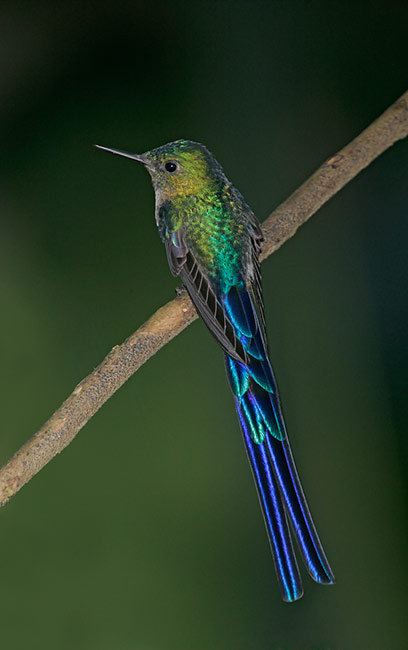
Violet-tailed Sylph, Tandayapa Bird Lodge, Ecuador
Image copyright 2006: Arthur Morris/BIRDS AS ART
Canon 400mm f/4 IS DO lens (tripod-mounted) with 25mm Extension Tube, 2X II TC, and EOS-1Ds Mark II. ISO 800. Manual Mode: 1/60 sec. at f/11. Flash as main light at +1/3 stop with Better Beamer. (Manual focus.)
I had just ten minutes left at Tandayapa and I was thinking that I had not gotten an image of this species from the rear when suddenly one landed on a clean perch well below the deck. This was a perfect situation as the bird was roughly parallel to the imaging sensor. I was too close to the bird so I said a prayer and moved my tripod back. I stopped down a bit to ensure getting the whole bird sharp (as is always necessary when photographing birds from behind.) Sometimes miracles do happen┘
DELKIN e-FILM PRO COMPACT FLASH CARDS/CRAZY LOW PRICES
As most of you know, I have used Delkin e-Film Pro Compact Flash Cards for more than 3 years now and have found them to be fast and dependable. I have been using the Delkin 2gb and 4gb cards exclusively now for more than two years and have experienced one card failure, that with a very old 2gb card about a month ago. Delkin promptly replaced the card. Do remember that I take tens of thousands of images in a given year. We have joined with Delkin to ensure that we can offer you the great e-Film Pro Cards at very low prices in any quantity that you might need:
1gb Delkin e-film Pro Card: $44.98
2gb Delkin e-film Pro Card: $74.98
4gb Delkin e-film Pro Card: $154.98
8gb Delkin e-film Pro Card: $299.98
Please add $7.00 per order shipping and handling. Florida residents please add 7% sales tax to the cost of the cards only.
Due in part to our ridiculously low prices, some sizes of Delkin Cards are on back order until the first week of August.
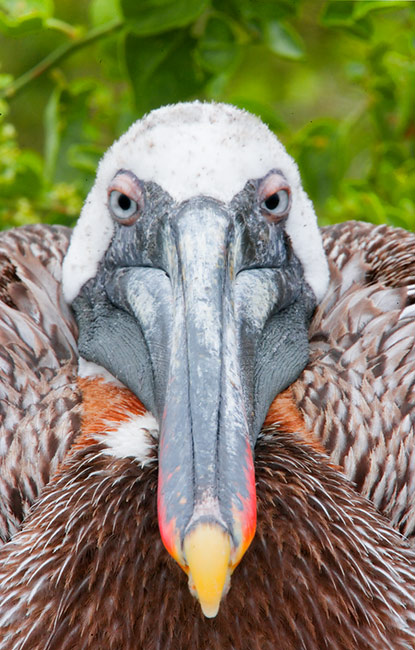
Brown Pelican, Rabida, Galapagos, Ecuador
Image copyright 2006: Arthur Morris/BIRDS AS ART
Canon 400mm f/4 IS DO lens (tripod-mounted) with 1.4X II TC and EOS-1Ds Mark II. ISO 400. Evaluative metering at zero: 1/6 sec. at f/45.
The shutter speed and the aperture here are not typos. I set the 2-second self timer and mirror lock before creating this image. I used Custom Function 4-3 to focus 1/3 of the way up the bill to maximize depth-of-field. (The zone of sharpness is twice as great beyond the point of focus than it is before the point of focus.) Of the twenty similar images that I created while this bird sat placidly on its nest, this one was the sharpest. (Many were lost due to subject movement.)
IPT UPDATES
Bosque#1:"The Fall Color IPT" NOV 14-16, 2006. Slide Program on the evening of NOV 13.3-DAY: $929.(SOLD OUT-WAIT LIST ONLY) Co-leader: Robert O'Toole. This IPT should feature a better chance for a day or two of the rare south winds that drastically improve flight photography and will definitely feature the brightest fall-color cottonwoods.
Bosque#2: "The Pre-Thanksgiving IPT" NOV 19-21, 2006. Slide Program on the evening of NOV 18.3-DAY: $929. (SOLD OUT-WAIT LIST ONLY) Co-leaders: Robert O'Toole and Alfred Forns. This and the next IPT have sold out for the past eight years .This IPT will feature increasing numbers of geese and cranes with lots of great opportunities. I will be hosting a Thanksgiving day lunch (strictly limited to 50 folks). If you would like to attend, please send a check for $30 per person and mark the check "Thanksgiving Lunch".
Bosque#3: "The Post-Thanksgiving IPT" NOV 25-27, 2006.Slide Program on the evening of NOV 24.3-DAY: $929. Co-leaders: Robert O'Toole and Alfred Forns. (SOLD OUT-WAIT LIST ONLY) This IPT has sold out for the past eight years as it is scheduled on dates that I consider peak for Bosque. I will be hosting a Thanksgiving day lunch (strictly limited to 50 folks). If you would like to attend, please send a check for $30 per person and mark the check "Thanksgiving Lunch".
Bosque#4: "The Full MoonIPT" DEC 4 (mid-day) through DEC 7 (mid day),2006.3-DAY: $929. (SOLD OUT-WAIT LIST ONLY)Slide Program mid-day on DEC 4. Co-leaders: Manuel Presti (2005 Wildlife Photographer of the Year) and Robert Amoruso. This IPT includes a half day of photography on the 4th, two full days of photography on the 5th and 6th, and a final half day on December 7th. Limit 14.This IPT has been scheduled to maximize the opportunities to include the rising and setting full (DEC 5) and near-full moon in your images. There will be lots of the usual chances as well, and this time period has provided more than its share of spectacular sunrises and sunsets over the years.
SW FLA Post X-mas IPT: DEC 27-29, 2006.Slide program on the evening of Tuesday, DEC 26. 3 -DAY: $1029. (Limit 14 Openings: 12.)Co-leaders: Robert O'Toole, Alfred Forns, & Robert Amoruso. Sanibel Island, Little Estero Lagoon, Venice Rookery, Cape Coral. Herons, egrets, gulls, terns, skimmers, shorebirds, both pelicans, Osprey, Burrowing Owl, and lots more.
San Diego IPT: FEB 3-6, 2007.4-FULL DAYS: $1359. Introductory slide program on the evening of Thursday, FEB 2. (Limit 12.) La Jolla, La Jolla Shores Beach, Coronado, and Santee Lakes. Brown Pelicans, Heerman's & Western Gulls, Marbled Godwits & lots more shorebirds, Wood & Ring-necked Ducks & Lesser Scaup. And lots more.
SW FLA President's Holiday IPT: FEB 17-21, 2007. Slide program on the evening Friday, FEB 16, 2007. 5-DAY: $1649. (Limit 14.)Co-leaders: Robert O'Toole, Alfred Forns, & Robert Amoruso. Sanibel Island, Little Estero Lagoon, Venice Rookery, Cape Coral. Herons, egrets, gulls, terns, skimmers, shorebirds, both pelicans, Osprey, Burrowing Owl, and lots more.
Fort DeSoto IPT: APR 13-15, 2007. Slide program on the evening of Thursday, APR 12. 3-DAY: $999 (Limit 14; openings: (9.) Co-leaders: Robert O'Toole, Alfred Forns, Robert Amoruso, and Todd Gustafson. Courtship and breeding behaviors of Laughing Gull and Royal and Sandwich Tern. Herons, egrets (including both dark and light phase Reddish Egret), shorebirds (including Long-billed Curlew), gulls, terns, and skimmers among others.
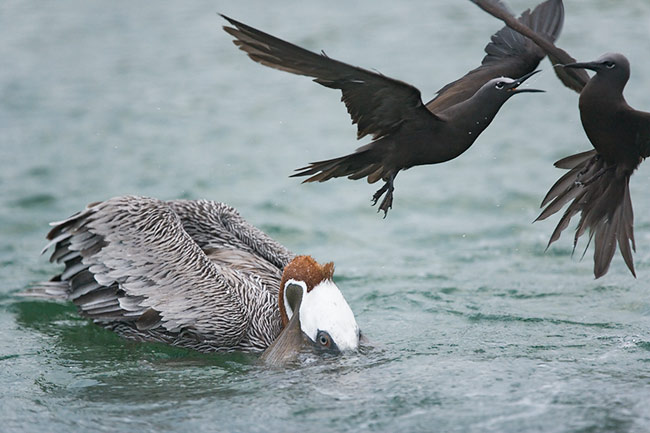
Brown Noddies arguing after trying to steal fish from Brown Pelican
Black Turtle Bay, Galapagos, Ecuador
Image copyright 2006: Arthur Morris/BIRDS AS ART
Canon 400mm f/4 IS DO lens (handheld) with EOS-1Ds Mark II. ISO 800. Evaluative metering +1 stop set manually after histogram check: 1/1000 sec. at f/4.
Though I was using the central sensor only, AF held here because I always have CF 17-2 set. This expands the number of active sensors to the 13 surrounding the selected sensor.
Best and love and great picture-making to all,
artie
Note: Arthur Morris has been a Canon contract photographer since 1994 and continues in that role today. Hunt's Photo of Boston, MA is a BAA sponsor as it Delkin Devices. Back issues of all BAA Bulletins can be found in the Bulletin Archives which may be accessed from the home page at www.birdsasart.com